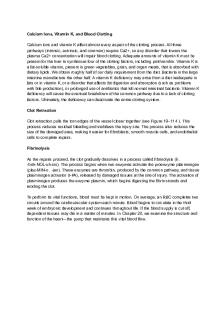Calcium Ions, Vitamin K, and Blood Clotting PDF

| Title | Calcium Ions, Vitamin K, and Blood Clotting |
|---|---|
| Course | Human Anatomy and Physiology with Lab II |
| Institution | The University of Texas at Dallas |
| Pages | 1 |
| File Size | 51 KB |
| File Type | |
| Total Downloads | 111 |
| Total Views | 157 |
Summary
Calcium Ions, Vitamin K, and Blood Clotting...
Description
Calcium Ions, Vitamin K, and Blood Clotting Calcium ions and vitamin K affect almost every aspect of the clotting process. All three pathways (intrinsic, extrinsic, and common) require Ca2+, so any disorder that lowers the plasma Ca2+ concentration will impair blood clotting. Adequate amounts of vitamin K must be present for the liver to synthesize four of the clotting factors, including prothrombin. Vitamin K is a fat-soluble vitamin, present in green vegetables, grain, and organ meats, that is absorbed with dietary lipids. We obtain roughly half of our daily requirement from the diet. Bacteria in the large intestine manufacture the other half. A vitamin K deficiency may arise from a diet inadequate in fats or in vitamin K, or a disorder that affects fat digestion and absorption (such as problems with bile production), or prolonged use of antibiotics that kill normal intestinal bacteria. Vitamin K deficiency will cause the eventual breakdown of the common pathway due to a lack of clotting factors. Ultimately, the deficiency can deactivate the entire clotting system. Clot Retraction Clot retraction pulls the torn edges of the vessel closer together (see Figure 19–11 4 ). This process reduces residual bleeding and stabilizes the injury site. The process also reduces the size of the damaged area, making it easier for fibroblasts, smooth muscle cells, and endothelial cells to complete repairs. Fibrinolysis As the repairs proceed, the clot gradually dissolves in a process called fibrinolysis (fı . -brih-NOL-uh-sis). The process begins when two enzymes activate the proenzyme plasminogen (plaz-MIN-o . -jen). These enzymes are thrombin, produced by the common pathway, and tissue plasminogen activator (t-PA), released by damaged tissues at the site of injury. The activation of plasminogen produces the enzyme plasmin, which begins digesting the fibrin strands and eroding the clot. To perform its vital functions, blood must be kept in motion. On average, an RBC completes two circuits around the cardiovascular system each minute. Blood begins to circulate in the third week of embryonic development and continues throughout life. If the blood supply is cut off, dependent tissues may die in a matter of minutes. In Chapter 20, we examine the structure and function of the heart—the pump that maintains this vital blood flow....
Similar Free PDFs

VITAMIN-K
- 4 Pages

Vitamin K
- 1 Pages

ANALISA VITAMIN K
- 1 Pages

Atoms, Molecules, and Ions
- 1 Pages

Calcium
- 1 Pages

Common ions - ions
- 1 Pages

Calcium gluconate
- 1 Pages

Calcium and Iron NRV Activity
- 3 Pages

Clotting Time & Bleeding Time
- 3 Pages

1.2 Atoms Isotopes and Ions
- 4 Pages

Vitamin Chart
- 5 Pages

Common ions
- 1 Pages

Common ions
- 4 Pages
Popular Institutions
- Tinajero National High School - Annex
- Politeknik Caltex Riau
- Yokohama City University
- SGT University
- University of Al-Qadisiyah
- Divine Word College of Vigan
- Techniek College Rotterdam
- Universidade de Santiago
- Universiti Teknologi MARA Cawangan Johor Kampus Pasir Gudang
- Poltekkes Kemenkes Yogyakarta
- Baguio City National High School
- Colegio san marcos
- preparatoria uno
- Centro de Bachillerato Tecnológico Industrial y de Servicios No. 107
- Dalian Maritime University
- Quang Trung Secondary School
- Colegio Tecnológico en Informática
- Corporación Regional de Educación Superior
- Grupo CEDVA
- Dar Al Uloom University
- Centro de Estudios Preuniversitarios de la Universidad Nacional de Ingeniería
- 上智大学
- Aakash International School, Nuna Majara
- San Felipe Neri Catholic School
- Kang Chiao International School - New Taipei City
- Misamis Occidental National High School
- Institución Educativa Escuela Normal Juan Ladrilleros
- Kolehiyo ng Pantukan
- Batanes State College
- Instituto Continental
- Sekolah Menengah Kejuruan Kesehatan Kaltara (Tarakan)
- Colegio de La Inmaculada Concepcion - Cebu


